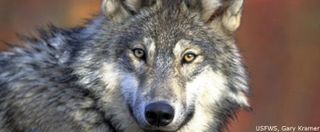Yellowstone Wolves Reintroduce 'Ecology of Fear'

The return of the Yellowstone wolf has elks shaking in their hooves, and that's good news for the national park's young aspen trees.
During the wolf's 70-year-long absence from the park as a result of being killed off by humans, elk were free to roam, reproduce and feed on the small aspen shoots. A new study finds the elk's fear and reduced population—both of which have been driven by the reintroduction of wolves begun in 1995—have improved the aspen's chance of survival.
"This is really exciting, and it’s great news for Yellowstone," said William Ripple of the Oregon State University College of Forestry. "We’ve seen some recovery of willows and cottonwood, but this is the first time we can document significant aspen growth, a tree species in decline all over the West. We’ve waited a long time to see this, but now we’re optimistic that things may be on the right track."
Stunted
Ripple and colleagues discovered that a significant number of aspen trees in the past decade have reached heights of more than 7 feet. That's a key long-term survival point, because it places tree crowns high enough to keep them safe from browsing by elks.
In contrast, no new trees were found surviving animal browsing from the 1920s to the early 1990s, when wolf packs were absent in Yellowstone.
The most impressive aspen comeback has occurred near streams and gullies in the northern part of the park. In these areas, wolves easily sneak up on elk and the terrain makes it difficult for elk to escape. The research team suggests elk are now avoiding these areas, allowing aspen shoots there to grow into adulthood.
Sign up for the Live Science daily newsletter now
Get the world’s most fascinating discoveries delivered straight to your inbox.
The scientists refer to this overall return to balance as "the ecology of fear." Their previous research has shown predators such as wolves and cougars strike fear into their prey and affect animal behavior and the surrounding environment.
"We did not document nearly as much [aspen] recovery in upland areas, at least so far, where elk apparently feel safer," Ripple said. "But even there, aspen are growing better in areas with logs or debris that would make it more difficult for elk to move quickly."
Fewer elk
Ripple also attributes the aspen's success to lower numbers of elk in the park. Since wolves have returned to Yellowstone, elk populations have declined steadily. Yet, the elk population is larger today than it was in the mid-1960s, when aspen trees were still in decline and wolves were still absent.
The researchers say this evidence suggests the fear felt by elk may be just as much of an influence, or even more of one, on aspen tree growth than elk population decline.
Equipped with a better understanding of this Yellowstone success story, scientists hope to improve the future of aspen trees outside of the national park's borders.
"The issue of aspen decline in the American West is huge, and their recovery will depend on local conditions and issues in many areas," Ripple said. "In northern Yellowstone, we finally have some good news to report."
- Top 10 Deadliest Animals
- Vote: Top 10 Most Destructive Creatures
- Return of Wolves Changes Ecosystem
Most Popular

